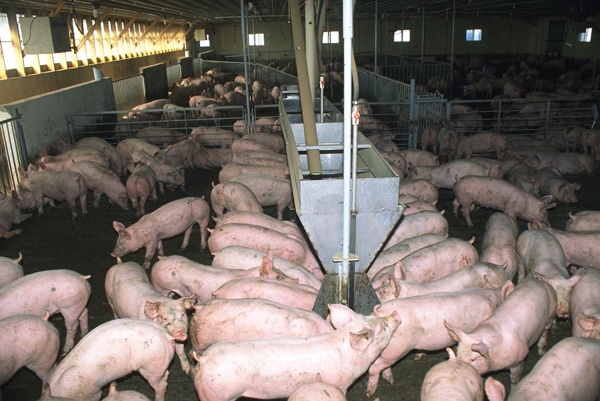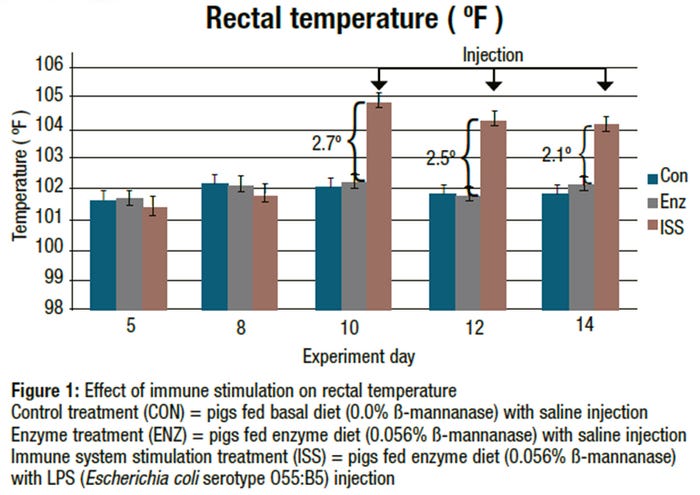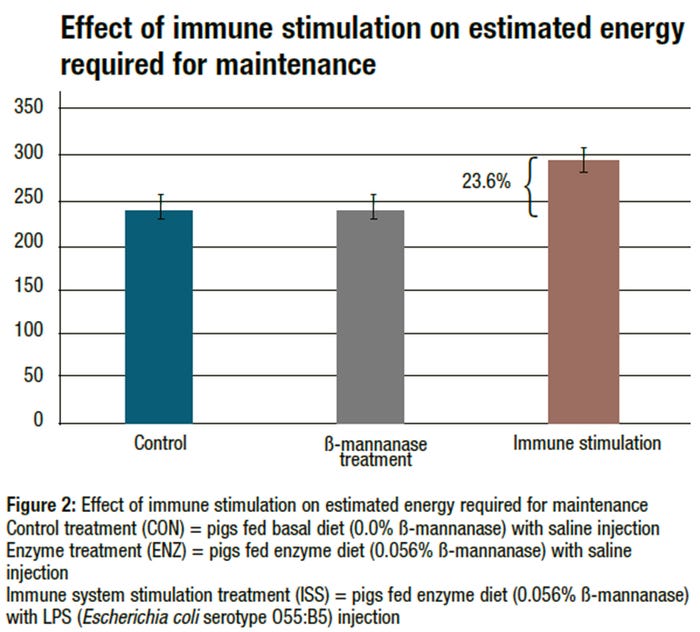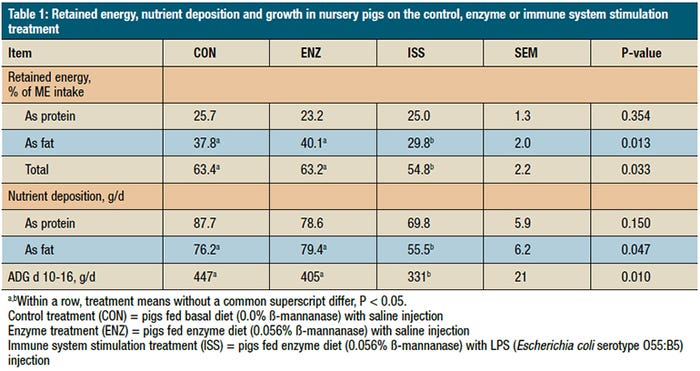Immune stimulation ups maintenance energy requirements
Any energy that is partitioned toward an immune response is not available for growth. Thus, health challenges impair production efficiency and profitability.
September 28, 2017

By Nichole F. Huntley and John F. Patience, Iowa State University Department of Animal Science; and C. Martin Nyachoti, University of Manitoba Department of Animal Science
Disease challenges drastically diminish pork production productivity and efficiency and have substantial negative economic impacts on producers. Sick pigs do not perform well; feed intake drops, growth slows and consequently days required to reach market weight increases. While symptoms of infection are well understood, research on the interactions between the immune response and nutrient metabolism is evolving almost daily.
To ensure health and vitality of the body, the immune system has high biological priority. Thus, when pathogens are detected, the immune response becomes the body’s energetic priority and changes how dietary nutrients and energy (i.e. calories) are utilized. During an immune response, specialized molecules are produced and distributed throughout the body to respond to invading pathogens. Cytokines are signaling molecules that aid cell-to-cell communication and stimulate the movement of cells toward sites of inflammation and infection. Acute phase proteins are those proteins for which blood concentrations change dramatically as part of an immune response.
Pro-inflammatory cytokines orchestrate an immune response resulting in fever, APP production and increased white blood cell production, each of which requires additional energy and amino acids. Therefore, an immune challenge can theoretically shift energy and nutrients away from productive processes such as growth and negatively impact production.
Immune activation occurs when certain molecular patterns associated with pathogens are detected, such as lipopolysaccharide. LPS contains cell fragments from E. coli that “trick” the immune system into thinking bacteria are present, and stimulates the front-line immune system to respond to an infection. But it is not just pathogens that can elicit this immune response. Certain dietary components, such as b-mannans that are found in soybean, copra and palm kernel meals, mimic pathogens and activate the immune system; when this happens, it is termed a feed-induced immune response. To prevent this from occurring, there is interest in supplementing an enzyme (β-mannanase) to break down the dietary mannans so they no longer stimulate the immune system.
Research in poultry has demonstrated performance improvements due to β-mannanase supplementation. In pigs, however, performance responses to β-mannanase are inconsistent.
Nutrient use in pigs during a true infection has received considerable attention, often utilizing an LPS challenge model. Similar to disease challenges, LPS decreases feed intake, causes fever and changes how amino acids and energy are used, all of which lead to decreased growth and efficiency. Few studies have addressed comprehensive changes in energy use during an immune response. The relationships between measured immune responses and the direction and magnitude of changes in energy use are still unknown.
The Applied Swine Nutrition research group at Iowa State University was interested in answering the question “how does an immune response impact pigs’ maintenance energy needs?” Our recent research reveals that it is more than just decreased feed intake that slows growth during an immune challenge.
A study was conducted to determine how immune stimulation and β-mannanase supplementation each affect maintenance energy requirements. The study was designed to also measure changes in immune parameters, nutrient digestibility, growth performance and energy balance.
Thirty growing barrows, weighing approximately 23 pounds, were assigned to one of three treatments. The control treatment received a corn, soybean meal and soy hulls-based diet, the enzyme treatment received the CON diet supplemented with β-mannanase, and the immune system stimulation treatment was challenged with four LPS injections and received the same diet as ENZ. The experiment consisted of a 10-day adaptation phase, a five-day total feces and urine collection phase and 34-hour measuring heat production using indirect calorimetry (Refer to sidebar below). Pigs were injected intramuscularly on days 10, 12, 14 and 16 with either sterile saline or a low dose of LPS to induce an immune response in the ISS treatment. During this challenge period, blood immune parameters (cytokines, APP and white blood cell concentrations), nutrient digestibility, nitrogen balance and maintenance energy requirements were measured to understand the larger picture of how the immune response influenced energy use in the pig.
Experiment results
We hypothesized that β-mannanase supplementation would decrease nursery pig maintenance energy requirements by alleviating excessive energy and nutrients being directed to an immune response. Our data did not support this hypothesis. Overall, this experiment provided no evidence for immune activation in CON or ENZ pigs. Pigs fed diets supplemented with β-mannanase had similar rectal temperature (Figure 1), white blood cell counts, cytokine concentrations, nutrient digestibility, average daily gain (Table 1), nitrogen and energy balance, protein and fat deposition, and maintenance energy requirements (Figure 2) compared to CON pigs.

A follow-up nursery trial with 480 pigs was conducted to test whether higher dietary β-mannan concentrations are necessary to induce an immune response in nursery pigs and if β-mannanase supplementation is more effective in such situations. Two levels of dietary mannan were achieved by replacing 10% of the soybean meal in the low mannan diet (0.36% mannan) with copra meal for a high mannan diet (2.79% mannan). Each of these diets was fed with and without 0.05% β-mannanase. Serum was collected for APP analysis on Day 0 (baseline) and on Day 28. There were no interactions between mannan level and β-mannanase supplementation overall or within each phase of the experiment. Overall, the high mannan diets decreased ADG and feed intake and β-mannanase did not affect growth performance or feed efficiency.
Serum APP concentrations were not affected by mannan level or β-mannanase supplementation, which supports the conclusions of the first study. In pigs, it seems that mannan-containing diets do not initiate a systemic immune response and β-mannanase supplementation did not spare energy in this manner, nor improve digestibility. These experiments provide immune data which was previously lacking in pig growth trials testing β-mannanase.
Practical U.S. diets are unlikely to contain sufficient mannan concentrations to induce an immune response and justify the use of β-mannanase for this purpose. However, other potential β-mannanase functions or modes of action, such as mannanoligosaccharide production and indirect influences on gut health, must still be considered.
LPS immune stimulation
Immune stimulation was successfully induced in pigs using E. coli LPS. Elevated rectal temperature, increased pro-inflammatory cytokine concentrations, and altered nutrient and energy partitioning are all hallmarks of a chronic immune challenge and were observed in ISS pigs in this study. The major finding of this research indicates that an inflammatory challenge increased young pig maintenance energy requirements by 23.6% (Figure 2) which translated into a 26.0% decrease in average daily gain (Table 1). In this study, decreased average daily gain could be attributed toward increased maintenance energy requirements in ISS pigs as opposed to decreased feed intake or effects on nutrient digestibility.

Decreased feed intake is a well-established response during an immune response; and the level of feed intake substantially influences energy requirements. Because of this, pigs were limit fed in this experiment to achieve similar feed intake across all treatments. Just as feed intake did not influence the observed decrease in average daily gain of ISS pigs, nutrient digestibility was not different across treatments.
Before the challenge period, rectal temperatures and blood immune parameters in ISS pigs were not different from those on the CON and ENZ treatments. This confirmed that prior to the challenge all pigs were in good health and of similar immune status. Therefore, any subsequent differences during the challenge were attributed to LPS immune stimulation. Immune stimulation through repeated LPS administrations induced fever (> 104 degrees F; (Figure 1). Fever is energetically expensive with increased caloric requirement estimates ranging from 7-15% for each 1 degree C increase in body temperature (Kluger 1978). The extra energy required for fever accounted for about 75% of the increase in maintenance energy requirements. The remaining 15% was likely related to other metabolic changes.
The serum concentration of key pro-inflammatory cytokines in the ISS pigs including TNFa, IL-6 and IL-1b were increased after LPS injection. Pro-inflammatory cytokines are produced during infection and shift metabolism away from growth processes to save energy for the immune system. Pro-inflammatory cytokines also initiate protein breakdown to free up amino acids and energy necessary to support fever and increased immune cell and APP production. In this study, the pro-inflammatory cytokine profile of ISS pigs clearly shifted metabolism resulting in significantly less energy retained as fat and decreased fat deposition compared to non-immunologically challenged pigs.
Often in disease studies, nitrogen metabolism is affected because of increasing amino acid requirements for immune cell and APP production. In this study, ISS pigs had numerically less protein deposition but this was not statistically significant (Table 1). We speculate that excessive amino acids in the diet may have provided the additional amino acids required and prevented the typically observed increase in skeletal muscle protein breakdown. Thus, the results indicated only numerical decreases in protein deposition in ISS pigs compared to CON and ENZ.

A considerable amount of research has focused on diet formulations or products to mitigate the drop in performance or prevent initial disease onset. Yet few studies have evaluated the magnitude of change in energy balance during an immune challenge to generate more effective dietary intervention strategies. In this study, energy partitioning between maintenance and growth was affected by ISS. As maintenance requirements increased to support the immune system, less dietary energy was retained for growth. This, in turn, resulting in decreased fat deposition (Table 1). Interpretation of our results in context with previously estimations of energy requirements during an immune challenge (Campos et al., 2014; Williams et al., 1997) indicates that during an immune response the number of dietary calories required may not drastically change because of decreased feed intake resulting in less energy required for digesting and metabolizing less food. But how those calories are used in the body does change and this results in decreased growth commonly observed during disease outbreaks.
Conclusions and implications
Dietary mannans and β-mannanase supplementation do not appear to impact nursery pig immune profile, nutrient digestibility, growth performance, energy balance or maintenance energy requirements. Repeated LPS immune stimulation induced a robust inflammatory response and elevated maintenance energy requirements by 23.6%. Energy repartitioning toward the immune response limited fat deposition by 27% leading to a 26% decrease in average daily gain during the immune challenge.
It is important to remember that in this experiment the pigs, by design, ate the same amount of feed. However, in a typical situation when pigs get sick, they also eat less feed, which compounds the problem of less energy being available for growth. As we start thinking about possible nutritional interventions to support optimal growth performance and feed efficiency during a health challenge, feeding a more energy-dense diet could be a potential strategy. Considering the intricate interaction among amino acids and energy, our finding that an immune response substantially shifts energy away from growth suggests it is likely that during disease challenges a mismatch occurs between dietary amino acids no longer being utilized for growth and the requirements for immune cell production and function. Aptly, this is a topic receiving considerable research attention in swine nutrition and immunology.
The results of our research demonstrating the substantial energetic cost of infection support the knowledge that there is great economic importance in maintaining a healthy population. Any energy that is partitioned toward an immune response is not available for growth. Thus, health challenges impair production efficiency and profitability. Incorporating this understanding into your production nutrition and economic models and decision making may help prioritize and incentivize maintenance of a high health herd.
References
Campos PHRF, Labussière E, Dubois S, Renaudeau D, Noblet J. Effects of ambient temperature on energy and nitrogen utilization in lipopolysaccharide-challenged growing pigs. J Anim Sci 2014;92:4909–20.
Kluger MJ. The evolution and adaptive value of fever. Am Sci. 1978;66:38–43.
Williams NH, Stahly TS, Zimmerman DR. Effect of chronic immune system activation on the rate, efficiency, and composition of growth and lysine needs of pigs fed from 6 to 27 kg. J Anim Sci 1997;75:2463–71.
What is indirect calorimetry?
Indirect calorimetry is a research technique that determines energy expenditure by measuring the composition of inspired and expired air. It is called “indirect” because the heat produced from burning calories is calculated from the amount of oxygen consumed and carbon dioxide produced by the pig.
Whenever most dietary components such as starch, amino acids and fat, are broken down, oxygen is used, and carbon dioxide is produced. The ratio of oxygen used to carbon dioxide produced reflects which components are being broken down. This reflects the metabolic rate (i.e. caloric burn rate) and provides information as to how those calories are being used, such as for maintenance, digestion, growth and activity.
You May Also Like



